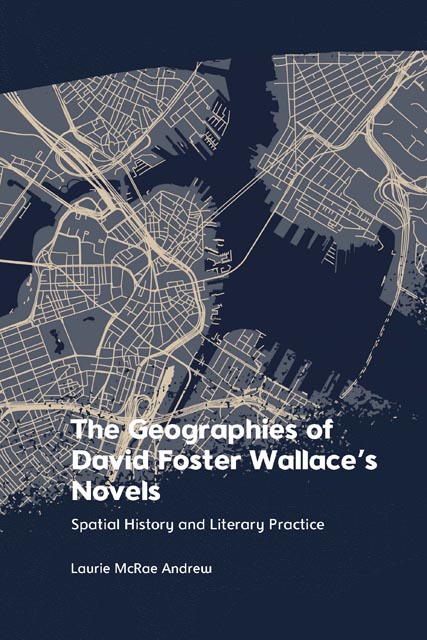Book contents
- Frontmatter
- Contents
- Acknowledgements
- Texts and Abbreviations
- Introduction
- 1 ‘This strange, occluded place’: Regional Geography, the Midwest and The Broom of the System
- 2 ‘Abroad in the urban night’ (I): Metropolis, ‘Postmetropolis’ and Infinite Jest
- 3 ‘Abroad in the urban night’ (II): Empathy, Community and the Image of the City in Infinite Jest
- 4 What is Peoria for? (I): Postindustrial Life and the Language of Place in The Pale King
- 5 What is Peoria for? (II): Peoria, the Edge City and The Pale King
- Bibliography
- Index
5 - What is Peoria for? (II): Peoria, the Edge City and The Pale King
Published online by Cambridge University Press: 13 April 2023
- Frontmatter
- Contents
- Acknowledgements
- Texts and Abbreviations
- Introduction
- 1 ‘This strange, occluded place’: Regional Geography, the Midwest and The Broom of the System
- 2 ‘Abroad in the urban night’ (I): Metropolis, ‘Postmetropolis’ and Infinite Jest
- 3 ‘Abroad in the urban night’ (II): Empathy, Community and the Image of the City in Infinite Jest
- 4 What is Peoria for? (I): Postindustrial Life and the Language of Place in The Pale King
- 5 What is Peoria for? (II): Peoria, the Edge City and The Pale King
- Bibliography
- Index
Summary
Introduction: Peoria and the ‘Edge City’
Over the first decade of Wallace’s work on The Pale King, the question ‘what is Peoria for?’ had opened the project onto searching questions about the efficacy of literary practice in the face of the geographical upheavals that characterised postindustrial life. Around 2005, though, the shape and status of the project itself began to come more fundamentally into question. In a note to himself dated 7 June 2005, Wallace reflected on the difficulty of incorporating his already drafted material into a coherent structure: he had been working to the assumption that ‘the book were a puzzle and all these pieces fit into it’, but ‘[t]his is not so’ (HRC 39.1). And this pragmatic structural issue was also joined by more fundamental doubts about the purpose of the work Wallace had done and was doing on the project: ‘The despair is that so much time and work has apparently gone into these nuggets, and so many of them just stop, as if the spirit just gave out’ – ‘I do not feel inspired’ (HRC 39.1). Across the ‘electric girl’ drafts, §1 and the Claude Sylvanshine section, the question of place had provided a focal point for Wallace’s renewed worry about the relationship between literary practice and the conditions of work and life in contemporary America. His 2005 note suggests that this conceptual concern had morphed into a compositional crisis.
David Hering places this note at the beginning of Wallace’s third and last phase of work on the novel, running from 2005 to 2007. As Hering points out, the note ‘clearly represents a crisis point in the life of The Pale King’ – necessitating ‘a new narrative strategy that [Wallace] clearly hoped would bring the disparate drafts together’. In Hering’s account, this strategy was the introduction of the character and narrative voice of ‘David Wallace’, who serves as the narrator of §9, §24 and §38 of the published text. At the same time, though – and in §24 in particular – this character’s appearance also coincides with a significantly more developed image of the Peoria Regional Examination Center and its surrounding landscape of ‘Lake James’, which began to form the geographical centre of the developing novel from this point.
- Type
- Chapter
- Information
- The Geographies of David Foster Wallace's NovelsSpatial History and Literary Practice, pp. 181 - 219Publisher: Edinburgh University PressPrint publication year: 2022



